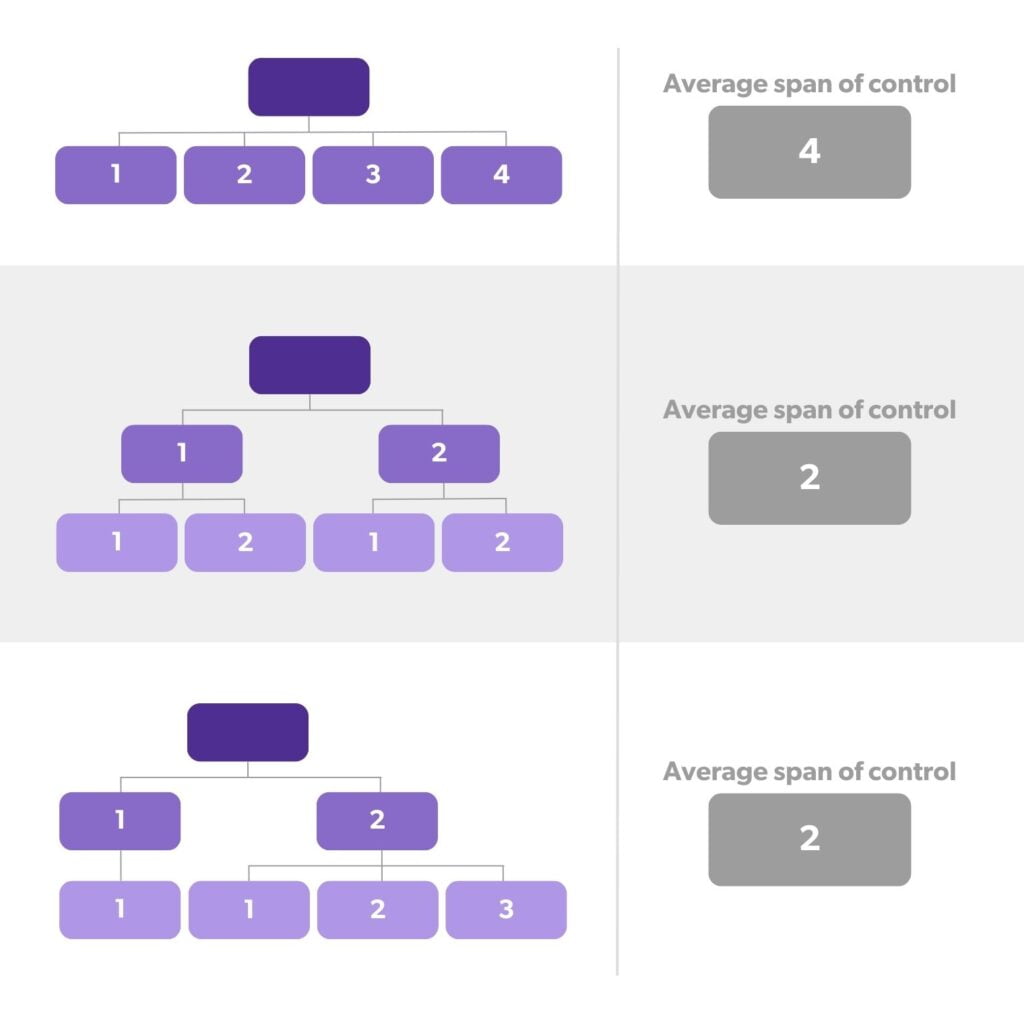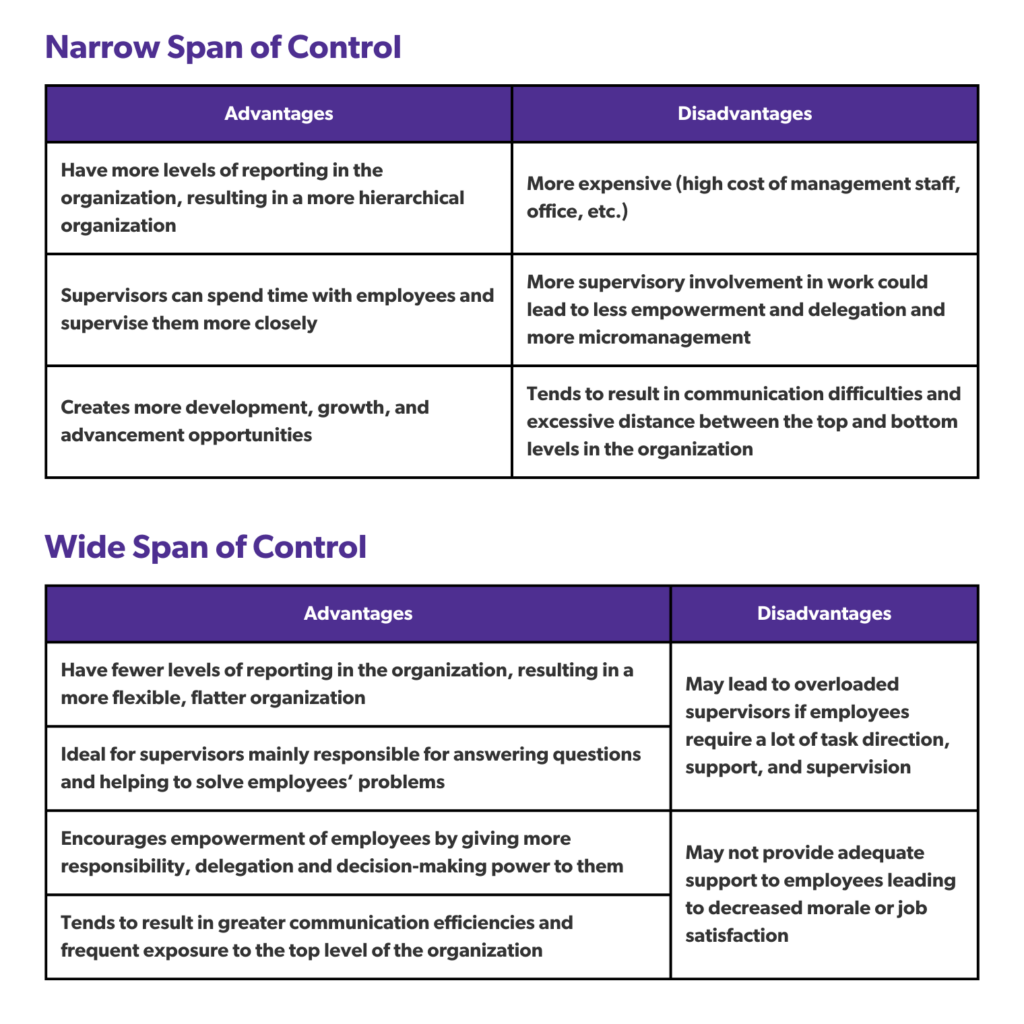
How many employees do your supervisors manage? Has your organization considered the effects of what narrow or wide supervisory and managerial spans of control mean for your employees and the levels of support and empowerment they receive on the job?
Defining Span of Control
Span of control refers to the number of team members that can be managed effectively and efficiently by a supervisor or manager in an organization. Typically, it is either narrow or wide resulting in a flatter or more hierarchical organizational structure. Each type has its inherent advantages and disadvantages.
Additional Resource
The Ultimate Guide to Training Your Supervisors and Managers
Learn how training your supervisors and managers will help them overcome challenges, motivate those around them, and be more effective in their roles.
Calculating Span of Control
If you’re looking to calculate the average span of control within a particular team of employees or even across an entire organization, simply add up the number of direct reports a manager or supervisor has and divide it by the total number of managers or supervisors. The image below provides some examples of how to calculate span of control:

Why is it Important to Calculate?
Have you considered how your decisions regarding the number of levels of reporting in your organization and given to your supervisors and managers influence job satisfaction, communication practices, and your overall organizational culture? The structure of your organization matters for these reasons and more.
- Efficiency and Effectiveness: Ensuring that supervisors have the right number of direct reports helps distribute workload evenly and prevents managers from being overwhelmed or underutilized. Having an ideal span means supervisors can provide the right amount of attention and support to each employee.
- Communication: Having the ideal span results in clear and consistent communication between supervisors and employees. It allows timely and constructive feedback from supervisor to employee and vice versa.
- Decision-Making: An optimal span of control will result in quicker and more informed decision-making.
- Employee Development: Supervisors with a manageable span of control can better facilitate professional development through mentoring and coaching.
- Job Satisfaction: Having sufficient structure can ensure that employees feel heard, supported, and not micromanaged or neglected. This will have a direct and positive effect on employee engagement and company culture.
- Organizational Culture: Having an effective management structure allows organizations to adapt to changes more easily and helps define the hierarchical levels of the organization.
Narrow Span
For supervisors and managers, a narrower span of control can be beneficial when the work is complex and requires close oversight and guidance to ensure quality. A narrower span of control can also be beneficial for teams that are: inexperienced, spread out geographically, or operating in an environment with frequent changes—all of these situations require more support and coordination to maintain high levels of performance.
| Pros of Narrow Span | Cons of Narrow Span |
|---|---|
| Have more levels of reporting in the organization, resulting in a more hierarchical organization | More expensive (high cost of management staff, office, etc.) |
| Supervisors can spend time with employees and supervise them more closely | More supervisory involvement in work could lead to less empowerment and delegation and more micromanagement |
| Creates more development, growth, and advancement opportunities | Tends to result in communication difficulties and excessive distance between the top and bottom levels in the organization |
Wide Span
A wider span of control can be beneficial for supervisors or managers when their team(s) perform routine, standardized, or even automated tasks that require minimal oversight. Additionally, if a team is particularly experienced or self-sufficient, less oversight is needed; and thus a wider span of control can be beneficial.
| Pros of Wide Span | Cons of Wide Span |
|---|---|
| Have fewer levels of reporting in the organization, resulting in a more flexible, flatter organization | May lead to overloaded supervisors if employees require a lot of task direction, support, and supervision |
| Ideal for supervisors mainly responsible for answering questions and helping to solve employees’ problems | May not provide adequate support to employees leading to decreased morale or job dissatisfaction |
| Encourages empowerment of employees by giving more responsibility, delegation and decision-making power to them | |
| Tends to result in greater communication efficiencies and frequent exposure to the top level of the organization |

Finding the Ideal or Optimal Span of Control
Three or four levels of reporting typically are sufficient for most organizations. While four to five are generally sufficient for all organizations except the largest organizations (Hattrup, 1993). This is consistent with ERC’s survey findings as well.
The ideal in an organization, according to modern organizational experts, is approximately 15 to 20 subordinates per supervisor or manager. However, some experts with a more traditional focus believe that five to six subordinates per supervisor or manager is ideal. In general, the optimum span of control depends on various factors including:
- Organization size: The size of an organization is a great influencer. Larger organizations tend to have wider spans of control than smaller organizations.
- Nature of an organization: The culture of an organization can influence span of control. A more relaxed, flexible culture is consistent with wide, while a hierarchical culture is consistent with narrow. It is important to consider the current and desired culture of the organization when determining span of control.
- Nature of job: Routine and low-complexity jobs/tasks require less supervision than jobs that are inherently complicated, loosely defined, and require frequent decision-making. Consider wider for jobs requiring less supervision and narrower for more complex and vague jobs.
- Skills and competencies of manager: More experienced supervisors or managers can generally be wider than less experienced supervisors. It’s best to also consider to what degree supervisors and managers are responsible for technical aspects of the job (non-managerial duties).
- Employees skills and abilities: Less experienced employees require more training, direction, and delegation (closer supervision, narrow); whereas more experienced employees require less training, direction, and delegation (less supervision, wider).
- Type of interaction between supervisors and employees: More frequent interaction/supervision is characteristic of a narrower span of control. Less interaction, such as supervisors primarily just answering questions and helping solve employee problems, is characteristic of a wider. The type of interaction you want your supervisors and managers to engage in with their employees should be consistent with the control they are given.
In addition, special consideration should be given to the direct reports of executive and senior management levels. Typically, the number of direct reports for these individuals is lower than supervisors and managers as too many direct reports at these levels can complicate communication and lengthen response time for crucial decisions.
Span of Control Based on Managerial Archetypes
In an article from McKinsey, experts propose that span of control can be different based on the role, or “managerial archetype” that an individual holds. The five archetypes are:
1. Player/Coach Archetype
This managerial archetype is engaged both in individual strategic work and leading a team, guiding them through a prolonged on-the-job training to build specific skills and expertise
Key Characteristics: High individual responsibility, extensive on-the-job training, non-standardized work, and mentorship.
Example Role: Vice President
Span of Control: 3-5 direct reports
2. Coach Archetype
The coach archetype balances personal responsibilities with a leadership role, directing a team through varied activities while providing supportive on-the-job training in a structured environment.
Key Characteristics: Significant individual responsibility, structured on-the-job training, and varied activities under established guidelines.
Example Role: Customer Analytics Manager
Span of Control: 6-7 direct reports
3. Supervisor Archetype
A supervisor manages through standardized processes, handling exceptions and providing moderate on-the-job training to ensure team adherence to company-specific procedures and guidelines.
Key Characteristics: Moderate individual responsibility, standardized processes, leadership in execution, and possible varied activities.
Examples: Accounting Manager
Span of Control: 8-10 direct reports
4. Facilitator Archetype
The facilitator focuses on managing the daily operations of a team, conducting standardized work, handling exceptions, and ensuring smooth adherence to established processes.
Key Characteristics: Limited individual responsibility, standard or automated work processes, and short-term skill acquisition for direct reports.
Example: Accounts receivable manager in a large finance organization
Span of Control: 11-15 direct reports.
5. Coordinator Archetype
The coordinator archetype directs a large team performing highly standardized tasks, with a focus on handling specific escalated issues and ensuring continued smooth operation.
Key Characteristics: Primary focus on managing daily work, high standardization or automation, and swift team self-sufficiency.
Example: Manager in a call center
Span of Control: 15 or more direct reports
Interested in learning more about training your supervisors?
Get a free preview of our supervisory training—receive instant access to a video highlighting our process, delivery methods, and success stories.
